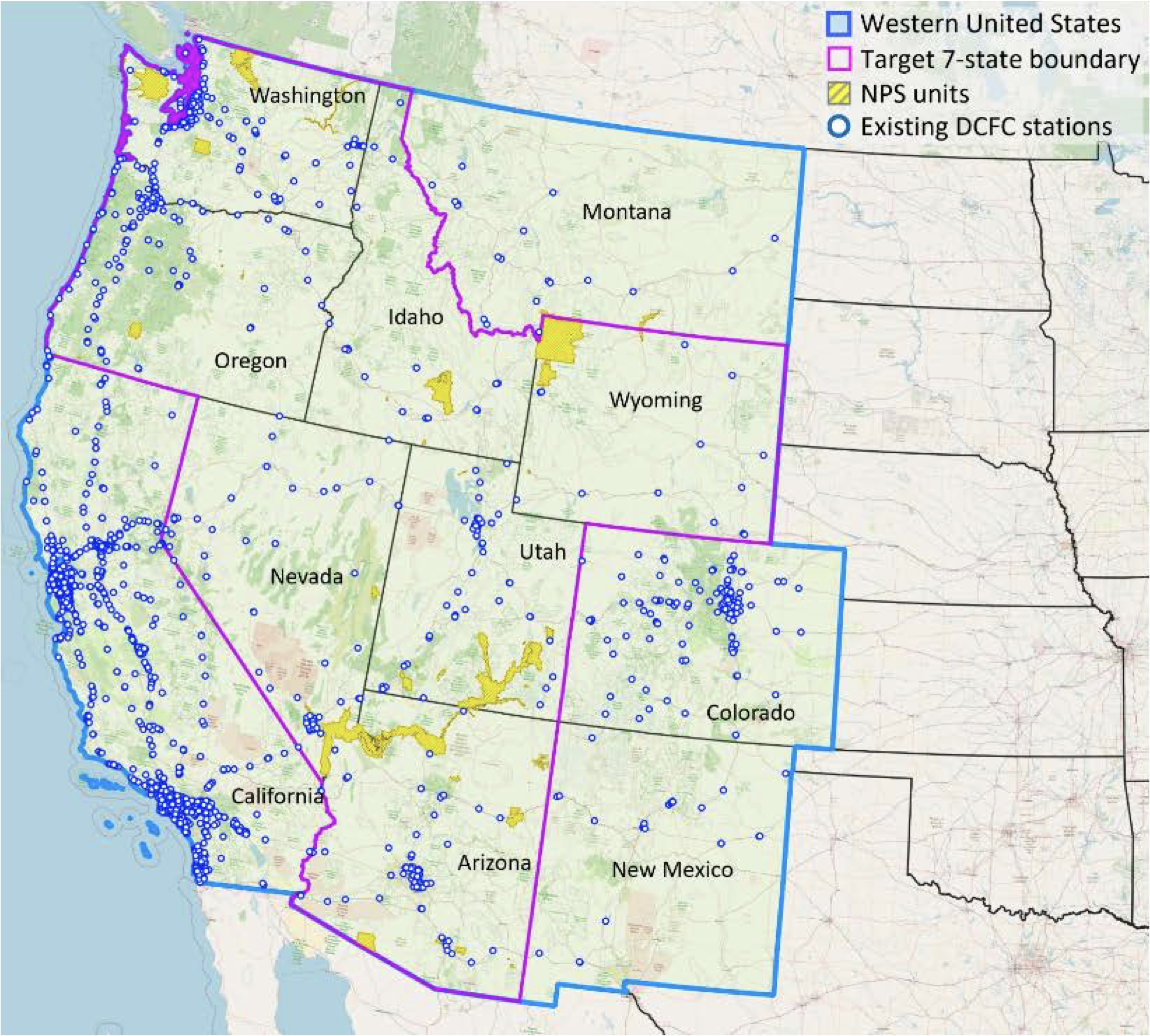Electric vehicle (EV) sales are expected to grow 30% to 50% by 2030. However Consumer Reports said that deciphering where and when to charge and range anxiety are some of the top roadblocks to scaling non-commercial EVs.
To see how stakeholders can address the public charging infrastructure gap between large cities or highly populated areas, the National Renewable Energy Laboratory (NREL) conducted a study. The report investigates the quantity and location of charging infrastructure needed to accommodate the projected 32 to 40 million light-duty EVs hitting the road by 2030.
The study was concentrated in areas surrounding national parks and monuments in Washington, Oregon, Idaho, Wyoming, Utah, Nevada, and Arizona. This region was selected due to the number of domestic and international visitors the parks attract yearly (41 million). California was excluded because previous statewide analysis has been conducted for regulatory and planning purposes in the region.
The study assumes that on-route charging stations will use direct current fast charging (DCFC) technology as it reduces traveler charging time. According to the Department of Energy, DCFC stations can charge an EV from 0% to 80% in 20 minutes to an hour.
Comparatively, Level 2 alternating current charging stations, typically used in residential and commercial spaces, can charge an EV from 0% to 80% in four to 10 hours. Researchers also estimate that most trips to and from national parks in the region total about 100 miles.
These assumptions provided the basis for investigating three proposed aspects of fast-charging infrastructure, that allow EV road trips to and from national parks in the western U.S.
They include:
- The quantity and location of on-route DCFC ports needed to support EV road trips to and from national parks in the seven aforementioned states.
- How on-route charging infrastructure projections may change in relation to season (high vs low tourism) and EV type (those towing trailers).
- The number of additional Level 2 charging stations needed to power a user’s car during rest periods.
Assuming there are nearly 40 million EVs on the road by 2030, researchers suggest the region needs between 2,350 and 4,610 DCFC ports. Moreover, this figure would depend on high (100%) or low (50%) utilization rates. Lastly, when drawing this estimate, researchers accounted for a 50-mile gap between stations and hybrid charging behavior. It’s also important to note that while California was excluded from the study area, researchers say the state still significantly influences the region as it has charging ports inter and intra-region drivers may use.
Regarding load profiles, researchers assumed the peak network-wide on-route DCFC load would be 140 MW.
“This load is roughly equivalent to 0.5% of the current electrical load for the northwest,” said the report. In this scenario, charging would peak at around 4 pm, stations would be about 50 miles apart and there would be high EV penetration.
As for level 2 chargers, researchers estimate that 50 to 100 additional ports need to be added to parks conducive to onsite charging. Spaces with larger parking areas and longer visiting times would work better than those with spread out, smaller parking areas and/or visitors who move their cars frequently.
Additionally, between 1,000 and 2,000 ports would need to be added to overnight lodges to fully accommodate the projected 1,000 to 2,000 hybrids and battery EVs. It’s important to note that not all EVs will need to be charged during park visits, and some visitors may opt out of staying at a lodge overnight.
Researchers leveraged the Federal Highway Administration’s Traveler Analysis Framework to better understand the current volume and pattern of passenger car road trips to, from and within National Parks in the western U.S. It also helped them estimate battery capacity and driving range for 2030 EV models.
They then paired each trip with short-range cars (SR-CAR), long-range cars (LR-Car) and pickup trucks (PUT). SR-CARs were assumed to have a 170-mile range at full charge and a 45kW/h battery by 2030. LR-CARs were expected to have a 450-mile range at full charge with a 125 kW/h battery in 2030. Lastly, PUTs were expected to have a 400-mile range and 125 kW/h battery in 2030. Various vehicle identification numbers were assigned to each pair to differentiate location, speed, energy consumption rate, charging demand, and charging power.
Researchers also used NREL’s Electric Vehicle Infrastructure for Road Trips (EVI-RoadTrip) tool. It calculates EV-charging station needs for long-distance travel based on individual simulations that allow it to pinpoint on-route charging needs and demands within a specific radius. This process was scaled to accommodate all the road trips in the study area, resulting in a proposed network of DCFC stations that meet 2030 EV infrastructure needs.
The study also referenced transportation data from various travel surveys and studies (NREL Transportation Secure Data Center) and applied NREL’s Future Automotive Systems Technology Simulation to estimate the effect of improving light, medium and heavy-duty vehicle efficiency, performance, cost, and battery life.
This content is protected by copyright and may not be reused. If you want to cooperate with us and would like to reuse some of our content, please contact: editors@pv-magazine.com.








By submitting this form you agree to pv magazine using your data for the purposes of publishing your comment.
Your personal data will only be disclosed or otherwise transmitted to third parties for the purposes of spam filtering or if this is necessary for technical maintenance of the website. Any other transfer to third parties will not take place unless this is justified on the basis of applicable data protection regulations or if pv magazine is legally obliged to do so.
You may revoke this consent at any time with effect for the future, in which case your personal data will be deleted immediately. Otherwise, your data will be deleted if pv magazine has processed your request or the purpose of data storage is fulfilled.
Further information on data privacy can be found in our Data Protection Policy.